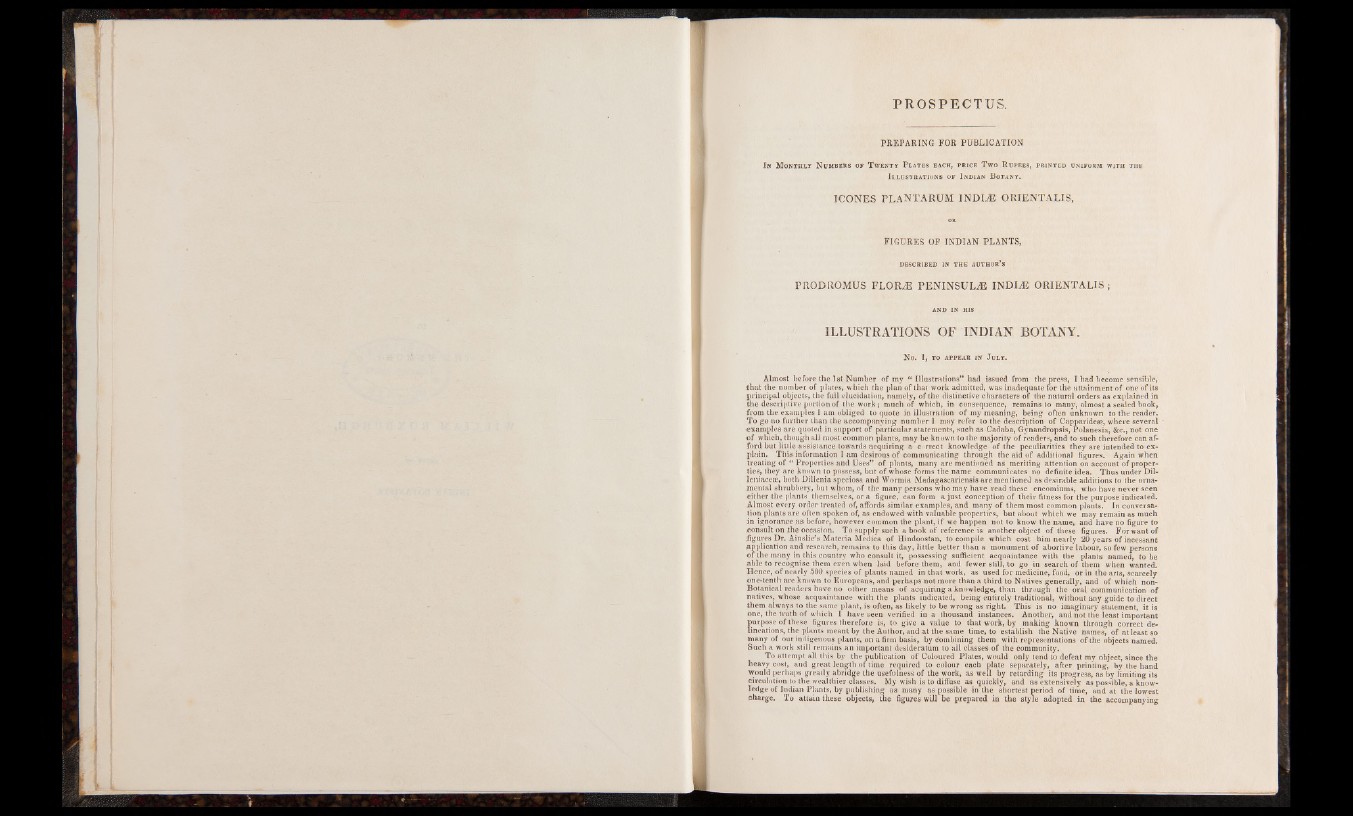
PROSPECTUS.
PREPARING FOR PUBLICATION
In M onthly N umbers of T wenty P lates each, price Two R upees, prin t ed uniform with the
I llustrations of I ndian B otany.
ICONES PLANTARUM INDIÆ ORIENTALIS,
FIGURES OF INDIAN PLANTS,
DESCRIBED IN THE AUTHOR’S
PRODROMUS FLORÆ PENINSULÆ INDIÆ ORIENTALIS;
AND IN HIS
ILLUSTRATIONS OF INDIAN BOTANY.
No. I, TO APPEAR IN JULY.
Almost before the I st Number of my “ Illustrations” had issued from the press, I had become sensible,
that the number of plates, which the plan of that work admitted, was inadequate for the attainment of one of its
principal objects, the full elucidation, namely, of the distinctive characters of the natural orders as explained in
the descriptive portion of the work; much of which, in consequence, remains to many, almost a sealed book,
from the examples I am obliged to quote in illustration of my meaning, being often unknown to the reader.
To go no further than the accompanying number 1 may refer to the description of Capparide®, where several
examples are quoted in support of particular statements, such as Cadaba, Gynandropsis, Polanesia, &c., not one
of which, though all most common plants, may be known to the majority of readers, and to such therefore can afford
but little assistance towards acquiring a correct knowledge of the peculiarities they are intended to explain.
This information I am desirous of communicating through the aid of additional figures. Again when
treating of “ Properties and Uses” of plants, many are mentioned as meriting attention on account o f properties,
they are known to possess, but of whose forms the name communicates no definite idea. Thus under Dil-
leniace®, both Dillenia speciosa and Wormia Madagascariensis are mentioned as desirable additions to the ornamental
shrubbery, but whom, of the many persons who may have read these encomiums, who have never seen
either the plants themselves, or a figure, can form a just conception of their fitness for the purpose indicated.
Almost every order treated of, affords similar examples, and many of them most common plants. In conversation
plants are often spoken of, as endowed with valuable properties, but about which we may remain as much
in ignorance as before, however common the plant, if we happen not to know the name, and have no figure to
.consult on the occasion. To supply such a book of reference is another object of these figures. For want of
figures Dr. Ainslie’s Materia Medica of Hindoostan, to compile which cost him nearly 20 years of incessant
■application and research, remains to this day, little better than a monument of abortive labour, so few persons
of the many in this country who consult it, possessing sufficient acquaintance with the plants named, to be
able to recognise them eyen when laid before them, and fewer still, to go in search of them when wanted.
Hence, of nearly 500 species of plants named in that work, as used for medicine, food, or in the arts, scarcely
one-tenth are known to Europeans, and perhaps not more than a third to Natives generally, and of which non-
Botanical readers have no other means of acquiring a knowledge, than through the oral communication of
natives, whose acquaintance with the plants indicated, being entirely traditional, without any guide to direct
them always to the same plant, is often, as likely to be wrong as right. This is no imaginary statement, it is
one, the truth of which I have seen verified in a thousand instances. Another, and not the least important
purpose of these figures therefore is, to give a value to that work, by making known through correct delineations,
the plants meant by the Author, and at the same time, to establish the Native names, of atleast so
many of our indigenous plants, on a firm basis, by Combining them with representations of the objects named.
Such a work still remains an important desideratum to all classes of the community.
To attempt all this by the publication of Coloured Plates, would only tend to defeat my object, since the
heavy cost, and great length of time required to colour each plate separately, after printing, by the hand
would perhaps greatly abridge the usefulness of the work, as well by retarding its progress, as by limiting its
circulation to the wealthier classes. My wish is to diffuse as quickly, and as extensively as possible, a knowledge
of Indian Plants, by publishing as many as possible in the shortest period of time, and at the lowest
charge. To attain these objects, the figures will be prepared in the style adopted in the accompanying